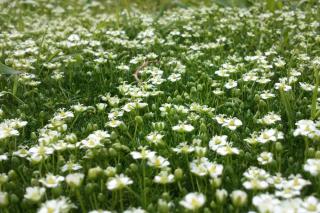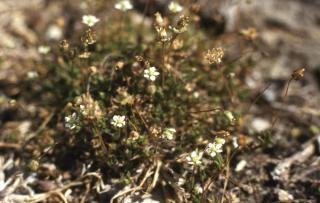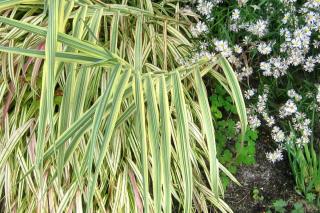

Heath pearlwort, or Scotch moss, spreads into a beautiful carpet with cute flowers.
Heath pearlwort facts
Botanical name – Sagina subulata
Family – Caryophyllaceae
Type – Perennial
Height – 1 to 2 inches (3 to 5 cm)
Exposure – part shade to full shade
Planting density – 25 to 30 plants per sq. yard (m²)
Soil: cool, any type, even poor – Flowering: summer – Foliage: evergreen
Considered an invasive by some, and an ornamental perennial by others, heath pearlwort is yet another of those controversial topics that involve weeds. Nonetheless, one thing is sure: it’s a magnificent ground cover plant.

Thanks to these peculiar leaves, heath pearlwort is very similar in appearance to moss.
In spring, hovering just above the leafage, white flowers appear. They bloom in incredible abundance, and if the weather is warm enough, you’ll even catch a whiff of its delicate fragrance. Heath pearlwort also comes in a special ‘Aurea’ variety that has beautiful gold-yellow foliage.
When you purchase it, heath pearlwort is often sold in rolls or in nursery pots, each one with a small one-inch square growing already (2-3 cm). When planting, space these about 6 inches apart (15 cm).
It’s important to think a bit about where to place your heath pearlwort: it’s best to find a spot in part shade where the soil stays relatively cool. Even if the soil is poor, it isn’t a problem, quite the opposite. Indeed, if it finds too much food and nutrients, the plant won’t stay lush and compact.
Planting it isn’t difficult, but you do have to fully pull weeds out beforehand. This has two purposes: first, you’ll protect your plant from undue competition, and second, weeds would mess with the beautiful aesthetics of your heath pearlwort.
The ideal planting period is, as often, the beginning of fall in order for roots to settle in well. Once you’ve cleared the small plot, simply:
Once properly settled in, Sagina subulata doesn’t require much special care:
 watch over soil moisture in summer, and water regularly (but in small quantities) during drought.
watch over soil moisture in summer, and water regularly (but in small quantities) during drought.Heath pearlwort can be propagated through clump division: cut small squares out from the outer portions of the plant, and put them in the ground as described in the planting section above. This lawn replacement plant self-sows spontaneously and might quickly turn invasive.
This is precisely what some gardeners hate about it, and why they call it an undesirable weed. Nonetheless, it’s possible to let these sprouts grow up a bit, and then you can transplant them to a more auspicious part of your garden.
Heath pearlwort doesn’t get sick. However, you might discover aphids and spider mites hiding among the leaves.
Sagina subulata is perfect to fill in slits between tiles, flow out from stone walls, and add greenery to spaces in rock gardens.

If your lot allows for it, why not try to integrate your Irish moss (as it’s also called) when re-sowing your lawn, planting it together with dwarf clover and the more traditional grassy species.